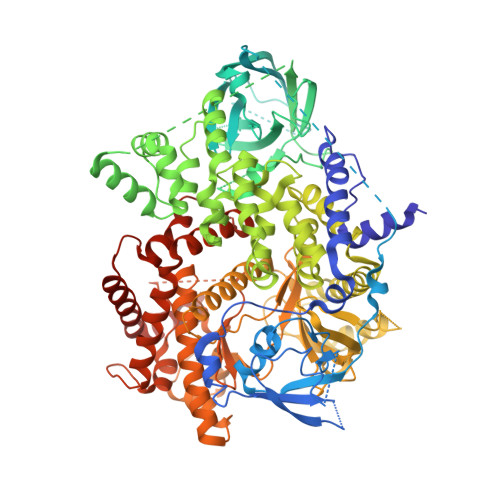Discovery and Optimization of a Series of Benzothiazole Phosphoinositide 3-Kinase (PI3K)/Mammalian Target of Rapamycin (mTOR) Dual Inhibitors.
D'Angelo, N.D., Kim, T.S., Andrews, K., Booker, S.K., Caenepeel, S., Chen, K., D'Amico, D., Freeman, D., Jiang, J., Liu, L., McCarter, J.D., San Miguel, T., Mullady, E.L., Schrag, M., Subramanian, R., Tang, J., Wahl, R.C., Wang, L., Whittington, D.A., Wu, T., Xi, N., Xu, Y., Yakowec, P., Yang, K., Zalameda, L.P., Zhang, N., Hughes, P., Norman, M.H.(2011) J Med Chem 54: 1789-1811
- PubMed: 21332118
- DOI: https://doi.org/10.1021/jm1014605
- Primary Citation of Related Structures:
3QJZ, 3QK0 - PubMed Abstract:
Phosphoinositide 3-kinase α (PI3Kα) is a lipid kinase that plays a key regulatory role in several cellular processes. The mutation or amplification of this kinase in humans has been implicated in the growth of multiple tumor types. Consequently, PI3Kα has become a target of intense research for drug discovery. Our studies began with the identification of benzothiazole compound 1 from a high throughput screen. Extensive SAR studies led to the discovery of sulfonamide 45 as an early lead, based on its in vitro cellular potency. Subsequent modifications of the central pyrimidine ring dramatically improved enzyme and cellular potency and led to the identification of chloropyridine 70. Further arylsulfonamide SAR studies optimized in vitro clearance and led to the identification of 82 as a potent dual inhibitor of PI3K and mTOR. This molecule exhibited potent enzyme and cell activity, low clearance, and high oral bioavailability. In addition, compound 82 demonstrated tumor growth inhibition in U-87 MG, A549, and HCT116 tumor xenograft models.
Organizational Affiliation:
Department of Medicinal Chemistry, Amgen Inc., One Amgen Center Drive, Thousand Oaks, California 91320-1799, United States. dangelo@amgen.com




















